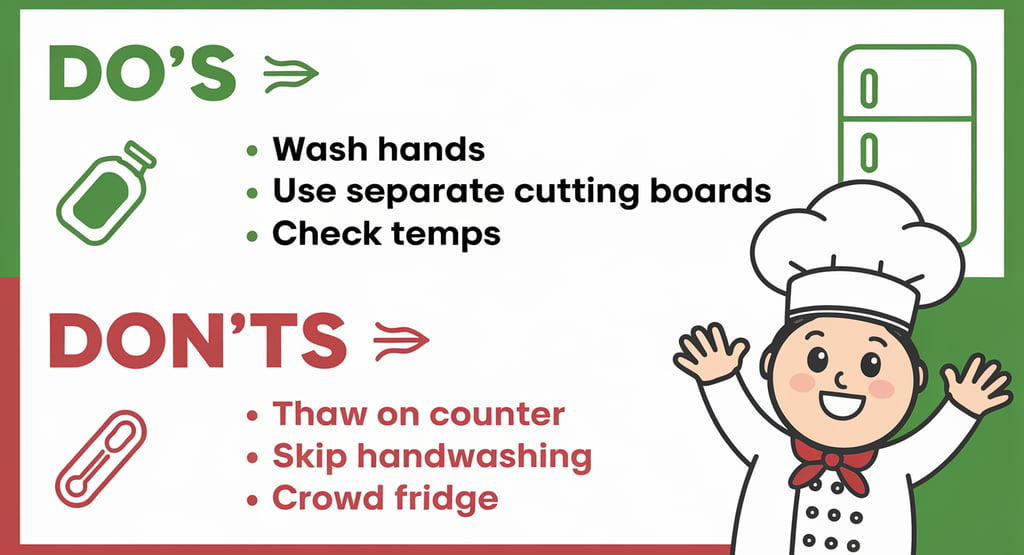Do’s and Don’ts of Kitchen Hygiene for Food Safety
A clean kitchen isn’t just about aesthetics—it’s a critical defense against foodborne illnesses. Every year, millions of people suffer from food poisoning due to poor kitchen hygiene. Whether you’re a home cook or a professional chef, following the right food safety practices can mean the difference between a delicious meal and a dangerous one. In this guide, we’ll break down the essential do’s and don’ts of kitchen hygiene to keep your food safe, your family healthy, and your cooking space spotless.
4/6/20252 min read


Do’s and Don’ts of Kitchen Hygiene for Food Safety
✅ The Do’s of Kitchen Hygiene
1. DO Wash Your Hands Properly (And Often!)
🧼 Why? Your hands are the biggest carriers of bacteria.
💡 How?
Use anti-bacterial hand soap and wash for at least 20 seconds (sing "Happy Birthday" twice!).
Scrub between fingers, under nails, and up to the wrists.
Wash before handling food, after touching raw meat, using the bathroom, and after handling trash.
2. DO Separate Raw and Cooked Foods
🍗 Why? Cross-contamination is a leading cause of food poisoning.
💡 How?
Use separate color-coded cutting boards for raw meat, poultry, seafood, and vegetables.
Store raw meats on the bottom fridge shelf.
Never reuse utensils or plates that touched raw food without washing.
3. DO Clean Surfaces and Utensils Thoroughly
🧽 Why? Bacteria can survive on countertops, knives, and sponges.
💡 How?
Sanitize with a bleach solution or use disinfectant kitchen wipes.
Replace sponges regularly or use a microwave-safe sponge.
Wash cutting boards with hot, soapy water.
4. DO Cook Food to Safe Temperatures
🌡️ Why? Heat kills harmful bacteria.
💡 How? Use a digital food thermometer to ensure:
Poultry: 165°F
Ground meats: 160°F
Fish: 145°F
Leftovers: Reheat to 165°F
5. DO Store Food Correctly
🧊 Why? Improper storage leads to spoilage and bacteria growth.
💡 How?
Keep the fridge below 40°F and freezer at 0°F.
Refrigerate leftovers within 2 hours.
❌ The Don’ts of Kitchen Hygiene
1. DON’T Skip Handwashing
Even clean-looking hands carry bacteria. Avoid rinsing quickly without soap or touching your face/phone while cooking.
2. DON’T Thaw Food on the Counter
Use the fridge or microwave with defrost setting instead.
3. DON’T Ignore Expiration Dates
"Use by" dates on dairy and meat are crucial. Use labeling tape and markers to track leftovers.
4. DON’T Let Pets in the Kitchen While Cooking
Keep your furry friends out to prevent accidental contamination.
5. DON’T Overcrowd the Fridge
Organize food with fridge storage bins for airflow and even cooling.
✅ Bonus: Common Kitchen Hygiene Myths Debunked
❌ Rinsing raw chicken spreads bacteria.
✅ Cooking thoroughly kills germs.
❌ “If it smells okay, it’s safe.”
✅ Dangerous bacteria don’t always affect smell or taste.
❌ Wood cutting boards are dirty.
✅ Both wood and plastic are safe if cleaned well.
Final Takeaways
✅ DO: Wash hands, separate foods, clean surfaces, cook properly, store safely.
❌ DON’T: Skip handwashing, thaw on the counter, ignore dates, allow pets, or crowd the fridge.
Your Turn!
What’s your #1 hygiene tip or kitchen safety fail? Drop your thoughts in the comments!
Join us on Pinterest
letstalk@lorybs.com
© 2025. All rights reserved.
